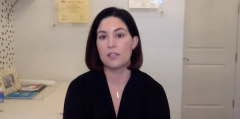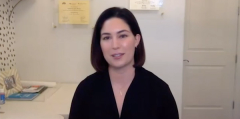
New and Pipeline BTK Inhibitors in CLL at the Frontline
Episodes in this series

Clinical pharmacy specialists review data on new and pipeline BTK inhibitors (acalabrutinib and LOXO-305, respectively) in the frontline setting for CLL.
Daniel Wojenski, PharmD, BCPS, BCOP: In terms of additional BTK inhibitors, such as acalabrutinib, there were 2 studies that had come out to support its use in the frontline setting. One was ELEVATE-TN, with 535 patients who had untreated CLL [chronic lymphocytic leukemia] and who were either 65 years or older or were younger than 65 with significant medical comorbidities. These patients received acalabrutinib, acalabrutinib with obinutuzumab, or chlorambucil with obinutuzumab. With a median follow-up of 28.3 months, acalabrutinib with or without obinutuzumab demonstrated progression-free survival [PFS] benefits over chlorambucil with obinutuzumab. The median was not reached in the acalabrutinib arm vs 22.6 months in the chlorambucil arm. That was a positive finding.
Limitations show that the comparison with acalabrutinib was to chlorambucil, and it would be more exciting to see it with more potent chemoimmunotherapy regimens used in healthier patients with CLL. But I do know that there are ongoing trials looking at acalabrutinib with current therapies, such as ibrutinib, which will certainly help answer a more appropriate standard of care.
Another trial that came out was ACE-CL-001, and it was the first phase 2 of acalabrutinib. The reason this is important is although it was a single-arm trial, it has the longest data that we have on safety and efficacy reported. This had 99 patients who were reported and treated with a median age of 64 years. Generally you had about 10% of patients with a deletion 17p and 62% who had an unmutated IGHV. Overall response rates were 97%, and what we saw was that with these patients, median event-free survival was not reached. At 48 months the event-free survival rate was 90%, so it was reassuring to see these long-term data.
With both of these BTK inhibitors, we have some information about either intolerance or resistance with these options. Therefore, additional options with BTK inhibition are always going to be beneficial for us to have in our pockets. That’s what was so exciting about ASH 2020 [American Society of Hematology Annual Meeting]. Dr [Anthony] Mato and colleagues presented on LOXO-305, which is a highly selective noncovalent BTK inhibitor. And they discussed the phase 1/2 BRUIN study. As I mentioned, LOXO-305 is a highly potent selective noncovalent BTK inhibitor with a greater than 300-fold selectivity for BTK vs 370 other kinases. It was designed to be efficacious in both wild-type BTK as well as in Cys481 disease, which is a mutation that generally incurs resistance for other BTK inhibitors that are available.
With LOXO-305, overall response rate was 63%, but it deepened over time. With patients who had been on it and had been followed in the study for over 10 months’ therapy with an overall response rate of 86%. This response rate was maintained for patients who had a previous BTK inhibitor, and most of these patients were heavily pretreated. These were exciting findings that they presented. The other thing that’s important to note is only 1.5% of the patients discontinued LOXO-305 for any reason. And we know that the adverse-effect profile was hopefully more favorable.
Of course, the longer you’re on a BTK inhibitor, the more risk of adverse effects, as we’ve seen with acalabrutinib and ibrutinib. But it’s still reassuring to see only 1.5% of patients discontinuing at this point. Risk of infection and serious infections were very low in this. Once again, these are single-arm data, so comparing this with relevant standards of care will be important. But the nice thing about this is that, especially as we’re using combination therapy—as you mentioned, Katie, in your previous conversation—we’re losing some of the sequential options we have later. To find something like this, a new BTK inhibitor that can overcome resistance mechanisms that we have with BTK inhibitors, as well as to be used sequentially after BTK inhibitors have already been used, is really invaluable to us. That’s a really exciting option.
There’s a lot that we’re excited about from ASH 2020, a lot of great therapies that we are moving forward with. BTK inhibition is something that we’re going to continue to look out for, new agents that are going to hopefully be more selective, have less toxicity, better outcomes. Then they’re likely going to be moving up into an up-front setting, as we’ve seen with acalabrutinib. There will be more exciting information to come with that.
Newsletter
Stay informed on drug updates, treatment guidelines, and pharmacy practice trends—subscribe to Pharmacy Times for weekly clinical insights.





















































































































































































































